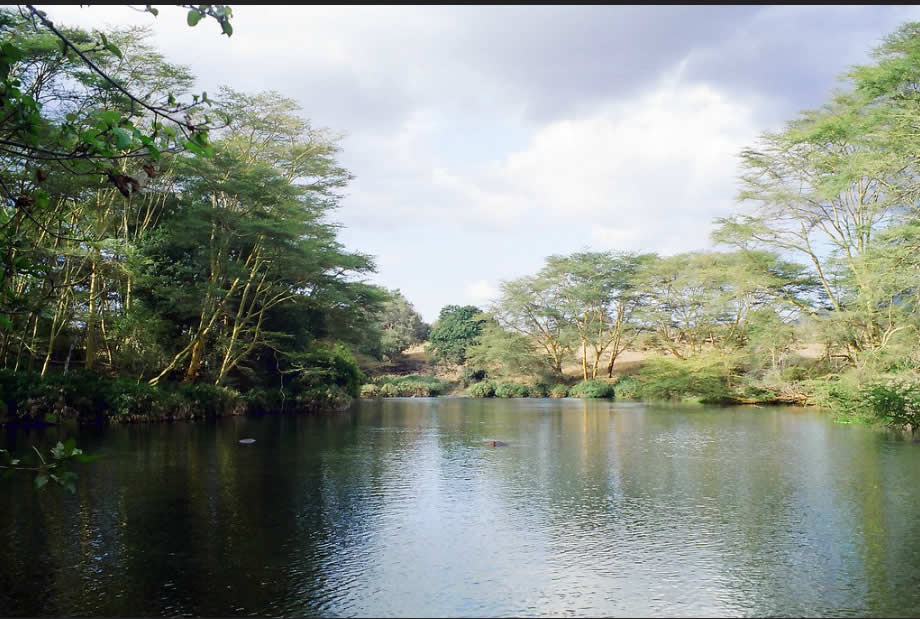Tsavo West National Park & Chyulu Hills





Fact File: Tsavo West National Park
Area & Altitude: The park covers 9065 sq km and the altitude and elevation ranges from 150 to 1800 m.a.s.l
By Road: The Park (Mtito Andei Gate) is 232km south of Nairobi and 250 km north of Mombasa on the main Nairobi- Mombasa Road.
Gates: Tsavo, Lake Jipe, Mtito Andei (Kamboyo HQ), Chyulu, Maktau and Ziwani.
Vegetation: The Park features over 1 000 plant species and a mixed habitat of bush, grasslands and acacia woodlands dotted with baobab, ivory palm, saltbush, doum palm, tamarind and fig trees.
Fauna: Include leopard, cheetah, buffalo, rhino, elephant, giraffe, zebra, lion, plains game, crocodile, mongoose, hyrax, dik dik, lesser kudu and the nocturnal porcupine.
Birds: The prolific bird life features 600 recorded species.
Tsavo West National Park & Chyulu Hills
Overview
Tsavo West national park is located in the coast province of Kenya. The parcovers an area of 9,065 square kilometers. The A109 road Nairobi-Mombasa and the new SGR railway divides it from the adjoining Tsavo East National Park. Together with adjoining ranches and protected area. Tsavo West is a more popular destination on account of its magnicent scenery, Mzima Springs, rich varied wildlife, good road system, rhino reserve, rock climbing potential and guided walks along the Tsavo River.
Chyulu Hills
Chyulu Hills are an impressive features that you should visit during your safari in Tsavo West national park, the hills are situated 150 kilometers east of Kenya rift and 30 kilometers from Kibwezi town. Chyulu hills form a 100 kilometers long volcanic eld covering an area of 741 square kilometers with the highest peak standing at the highest of 2188 kilometers, the hills create a magnicent scenic view which is perfect for sightseeing and photography. Chyulu Hills has today become a full fledged national park (Chyulu Hills National Park) gazetted in ______.
Nature's Archictectural Prowess in a Land of Lava, Springs & Grotesque Geometry
Tsavo West is nature's painting on a sprawling canvas of endless skies, emerald hills, liquid lava flows, palm fringed rivers, teeming wildlife and a sparkling oasis set against the unforgettable backdrop of miles upon miles of cloud-shadowed African savannah. What a place in Africa to be!
Wildlife in Tsavo West National Park
Tsavo west national park has a variety of wildlife species such as the eastern black rhinoceros, hippopotamus, cape buffalo, elephant, leopard, lion and many more, there are also other smaller animals that can be spotted in the park such as bushbaby, hartebeest, lesser kudu, Maasai giraffe and many more.
Bird species
Tsavo west prolic birdlife features over 400-recorded species. The park has bird species that includes African nfoot, Corncrake, Golden pipit, lesser kestrel starling, Martial warbler, Narinai trogon, Northern brownbul and many more.
Tsavo West National Park - Map
Tsavo West Safari Experience - Adventure Galore
Mzima Springs.
Mzima springs are a series of the four natural springs in Tsavo national park, Kenya. They are located in the west of the park, around 48 km from Mtito Andei, the source of the springs is a natural reservoir under the Chyulu Hills to the north.
Poacher’s outlook.
Poacher’s hill is a magnicent feature to visit on your safari in Tsavo West national park, poacher’s outlook offers 360 degrees panoramic views of the grand Tsavo West national park, originally the hill was used by the poacher’s to look out for elephants and rhinos before gazetting of the area. Mzima springs is one of Tsavo’s most popular wildlife attractions owing to its resident populations of the hippos and the Nile crocodiles.
Shetani Lava Flow.
Shetani Lava is about 4km west of the chyulu gate of Tsavo West national park, on the road to Amboseli are the spectacular Shetani lava ows, ‘Shetani means ‘devil’ in Kiswahili, the ows were formed only a few hundred year ago and local peoples believed that it was the devil himself emerging from the earth. This vast expanse off folded black lava spreads for 50 sq.km across the savannah near the Chyulu Hills, looking strangely as if Vesuvius dropped its comfort blanket here.
Ngulia rhino sanctuary.
Ngulia rhino sanctuary is a stronghold and bleeding place for black rhinos in Tsavo and Kenya as a nation, Kenya as a tourist destination and a home of wildlife used to be a habitat to over 8000 black rhino individuals by 1970’s but due to human practices like poaching and encroaching the rhino’s habitants. Ngulia Rhino sanctuary has over 80 rhino individuals which are easy to spot while on your visit in the sanctuary as you can as well spot the black rhinos but you can also spot leopards and elephants.
Chaimu hill.
Chaimu hill has a great observation point while enjoying the views of Tsavo West national park and the views of Majestic Mountain Kilimanjaro from a distance, this hill is great for hiking which takes approximately 20 minutes of hike.
Roaring rocks.
Roaring rocks are spectacular feature in Tsavo West national park resembling the same spot in lion king where mufasa holds Simba showing the young to the animals he led as a king, these rocks are situated near Ngulia rhino sanctuary and for a long time these rocks have been an observation point.
A Vibrant Volcanic Arena:
The molten lava that forms the Shetani Lava Flow spewed from the earth just 200 years ago and its fiery fury was thought by the local people to be the work of the Devil, hence its name which means 'Devil' in Swahili. The Chaimu Crater is an alternative volcanic arena (which can be climbed by those who feel fit enough), as are the imposing Ngulia Hills and the enchanting Chyulu Hills. Finally, the eerie 'Roaring Rocks' are named after the buzz of the cicadas that inhabit them and the howl of the wind as it rushes past the sheer face of the scarp.
Where to Stay
- Finch Hatton's Tented Lodge - Winner, World Travel Awards 2022 - Best Tented Camp in Africa
- Voyager Safari Camp.
- Kitani Severin Safari Camp.
- Ngulia Safari Lodge.
- Kilaguni Safari Serena Lodge.
Lake Jipe.
Lake Jipe is found in Tsavo West national park, lying across the Kenyan/Tanzanian border, a beautiful Lake that was once the unique jewel of Tsavo West, being the only natural lake in the vast 8,000 square mile arid scrubland that comprises Kenya’s famous Tsavo National Park.
Activities done in Tsavo West national park
The Game Drives:
Tsavo offers some of the most magnificent game viewing in the world - vast herds of dust-red elephant, fat pods of hippo, giant crocodile, teeming herds of plains game, a fantasia of bird life and some magical flora. You could also take in a visit to the Nguila Rhino Sanctuary where Tsavo's growing population of endangered black rhino are inching their way back from the chasm of extinction that was forced upon them by rampant poaching in the 1960's. Alternatively you could explore beautiful Lake Jipe, which lies astride the Kenya - Tanzania border and is teeming with aquatic life. (Boat hire is available). Bird watching is also a major activity in the park.
Bird watching.
Tsavo West national park is abiding destination in Kenya, Ngulia Hills, being one of the landmarks in the park, is situated along one of the world’s busiest avian migration routes, Bird ringers make an annual pilgrimage here between October and January. Ngulai is the site of Africa’s foremost bird-ringing (tagging to enable individual bird identication) project. More than 100 migrant and resident species have been ringed here, the most prolic being marsh warbler, river warbler, redbacked shrike, thrush nightingale and common whitethroat and many more.
Cave exploration.
The Shetani caves, located next to the Shetani lava ows, were formed as a result of the volcanic activity, the guests can visit these caves to learn about their attached history. While at the caves, there is a high possibility of seeing hyenas and other small mammals. Exploring the cave requires one to carry a torch for lighting since it gets dark when in there.
Rock climbing.
Tsavo West national park offers some of the best rock climbing adventures in Kenya safaris, as the most impressive rock climb is the famous 300m Kichwa Tembo rock which attracted the rst adventure and later, the second expedition to conquer the impressive Tsavo Chimney, other hiking and rock climbing areas includes the Ngulia Hills, Mastodon and ivory tower as they have viewpoints that allows you to have a panoramic view of the landscapes, large herds of elephants roaming the vast plains and ocks of birds in the park








